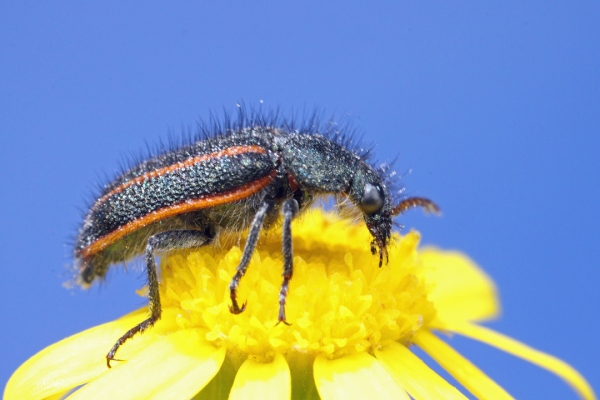Last March I discovered La Reserva Ecológica Costanera Sur—a gem of natural beauty in the heart of Buenos Aires, Argentina. Though its origins are semi-artificial, its biota a mix of native and introduced species, and its pathways continually choked with pedestrians and cyclists, for me it is a refuge—a place where I can spend an entire day looking for insects without ever retracing my footsteps. Last Sunday after arriving in Buenos Aires, I couldn’t check into my hotel and change into my “bug collecting clothes” fast enough before making a beeline to the Reserve just a few blocks away. I “discovered” a huge area on the east side of the Preserve that I hadn’t found during my last visit that was devoid of paved paths—and thus people—and spent the next several hours rummaging through the brush looking for insects to photograph. Early November is early spring in Buenos Aires, and insect activity was still just beginning. I did find a number of insects to photograph, though not as many as I had found during my early March visit.
This butterfly, which I regard as Actinote carycina (Yellow Lazy), was common around stands of a purple-flowered plant. I watched this particular individual flit endlessly back and forth in front of one particular stand, rarely pausing long enough to allow a shot or two before resuming its patrols. Vigorous aerial battles ensued every time another individual approached the stand, and although I can’t say for sure that it was this individual that always won, the same patrolling flight pattern resumed as soon as one of the contestants flew away.
Beetles were scarce, but I saw this particular species of Melyridae (presumably in the genus Astylus, and thus a close relative of Astylus atromaculatus or “spotted maize beetle”). I don’t normally do random “bug-on-a-flower” photos, but I’ve recently become enamored with the use of “blue sky technique” for insect macrophotography and thought the red and black color of the beetle against the yellow flower it was feeding on was well suited for a blue background. The beetle was quite small (only ~6 mm in length), thus requiring the 65mm 1–5X lens and full-flash illumination. Normally this would result in a black background unless something is placed behind the subject, and I suppose I could just carry around a colored cards for placing behind subjects to get whatever color background I want. However, there is something appealing to me in having the ability to achieve a blue sky by actually using the sky, despite the trickiness of the technique. In this case, I played with ISO settings of 400–640 and shutter speeds of 1/100 to 1/125 sec (settling at the high end of each range for this photo) to get the color of the sky true, then used low F.E.C. settings (-1 2/3 in this case) to temper the illumination of the subject. I’m still not completely happy with the results—there is more motion blur in the photo than I would like, and I burned the yellows a little too much as well. I think ISO800 and F.E.C. -2 or even lower would have given better results. At any rate, this photo was the best of the bunch, and it will have to do.
Copyright © Ted C. MacRae 2011



The blue sky is very cool behind the yellow flower & Halloween-colored beetle. I like the one of the city too. It reminds me of the view from some of birding spots in East St. Louis, looking back at the arch.
The juxtaposition of wild on urban makes for an interesting scene.
I just love the fully-upright fur on the melyrid beetle, as though it just stuck a tarsus in an electrical outlet.
Me too – too bad the clarity isn’t better.
I almost said something about the beetle needing a haircut!
Keep your eyes open for some photogenic ants. 🙂
Camponotus mus and Pseudomyrmex last March wasn’t enough, huh?
Actually, I did see some some more C. mus when I peeled back bark (on the very same burned tree that I fotographed one last March), but they scattered too uncooperatively. Bugs were pretty scarce that day until I found the new area to the east, and then it was mostly small beetles.
Yes, I must be thankful for those small favors, as for much else, today.
But I am curious – No fire ants en la reserva?
I don’t recall seeing fire ants in or near Buenos Aires, although a quick search reveals it was recently recorded specifically from La Reserva (with a little help from you :)).
Wow, this looks like such an amazing place. I’m always surprised at how vibrant these “semi-artificial” natural areas can be. And the lovely creatures you photographed just go to show how much every city needs an oasis like this!
I’ve been fortunate enough to see lots and lots of “real” wild places. Although a place like this can’t really compare to the real thing, it still provides the feeling of one. Each time I’ve gone there I’ve spent the entire day bushwhacking as if I were in some remote wilderness.
Creo que el punto de vista es el correcto para tener una vision completa del insecto, con los detalles de la pilosidad de sus elitros y su color intenso, sus ojos asi como parte del aparato masticador EXCELENTE!!
Estimo pude ser Astylus vittaticolis (Melyridae).
saludos
Dr CMARZANO
Gracias, Dr. Marzano, por su comentario muy amable. Me encontré con varias fotos de A. vittaticollis después de su comentario y estoy de acuerdo que un aspecto muy similar a la del escarabajo en mi foto.
Saludos,
Ted
Pingback: Le Printemps à Buenos Aires arrive enfin! | Bsas4u
Pingback: Spring in Buenos Aires has finally sprung! | Daytours4u